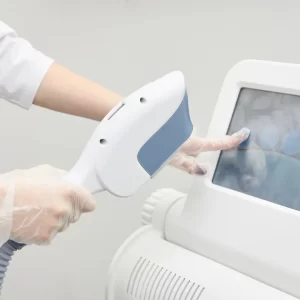In the quest for smooth, hair-free skin, many turn to laser hair removal, a popular cosmetic procedure renowned for its efficacy and long-lasting results.
This innovative technology offers a promising solution to the age-old problem of unwanted hair, whether it’s on the face, underarms, legs, or bikini area.
Unlike traditional methods such as shaving, waxing, or plucking, which provide temporary solutions and often lead to irritation or ingrown hairs, laser hair removal targets hair at the follicle level, promising a reduction in hair growth over time.
But a common question looms large for anyone considering this procedure: Does laser hair removal hurt? Given the diverse pain thresholds and the different areas of the body involved, it’s a pertinent question.
Understanding the sensation experienced during laser hair removal is crucial for those on the fence about this treatment.
With advancements in laser technology and professional expertise, the procedure has been refined to enhance comfort and effectiveness.
Yet, the experience of pain is subjective and can vary widely among individuals.
In this article,
we delve into the world of laser hair removal, offering insights into what the procedure entails, who stands to benefit most, and crucially, what one can expect in terms of discomfort.
By providing a comprehensive overview, we aim to dispel myths and set realistic expectations, making the journey toward hair-free skin as clear and comfortable as possible.
Let’s embark on this exploration, shedding light on the intricacies of laser hair removal, and addressing the burning question of pain, so you can make an informed decision that aligns with your beauty and wellness goals.
In the following sections, we’ll break down the procedure, its suitability for different skin and hair types, and share firsthand accounts and expert advice on managing discomfort.
Whether you’re contemplating laser hair removal for cosmetic reasons or to address medical concerns, this guide will equip you with the knowledge you need to approach your treatment with confidence.
What is Laser Hair Removal?
Laser hair removal stands as a beacon of innovation in cosmetic procedures, offering individuals a pathway to reduce unwanted body hair with greater longevity and effectiveness than traditional methods.
At its core, this noninvasive treatment employs laser technology to target and destroy hair follicles, thereby inhibiting future hair growth.
Understanding the mechanics and benefits of this procedure is essential for anyone considering it as an option for hair removal.
The Science Behind the Procedure
The principle of selective photothermolysis underpins laser hair removal.
This sophisticated process involves the use of a concentrated beam of light (laser) that is absorbed by the pigment (melanin) in the hair.
The light energy is converted to heat, which damages the hair follicles responsible for hair growth while sparing the surrounding skin from harm.
This targeted approach is what makes laser hair removal an efficient and sought-after method for reducing hair growth over the long term.
Most commonly treated areas include the face, underarms, legs, bikini area, and back, addressing both cosmetic desires and medical conditions that result in excessive hair growth, such as hirsutism or hypertrichosis.
The versatility and precision of laser hair removal have made it a favored choice for many seeking smoother, hair-free skin.
Suitability and Effectiveness
Laser hair removal’s effectiveness varies with hair color, thickness, and the area being treated, as well as the individual’s skin type.
The procedure is most efficient for individuals with light skin and dark hair due to the contrast in pigment, allowing the laser to more easily target the hair follicle.
However, advances in laser technology have broadened its applicability, making it a viable option for people with darker skin tones as well.
Despite its broad appeal, laser hair removal may not be suitable for everyone.
Those with very light-colored hair (blonde, grey, white, or red) may find the treatment less effective because their hair lacks sufficient pigment to absorb the laser energy.
Moreover,
certain medical conditions and medications can influence the decision to undergo laser hair removal, necessitating a thorough consultation with a healthcare provider to determine suitability.
In summary, laser hair removal offers a promising solution for those seeking to diminish unwanted hair growth.
Its noninvasive nature, combined with the potential for long-lasting results, makes it an attractive option for many.
However, understanding the science behind the procedure and assessing individual suitability are critical steps before embarking on this cosmetic journey.
The Pain Factor: What to Expect
One of the most common concerns about laser hair removal is the level of discomfort it may cause.
This section aims to shed light on what individuals can expect in terms of sensation during the treatment and factors that might influence the experience of pain.
Sensations During Treatment
The sensation experienced during laser hair removal is often compared to the feeling of a rubber band snapping against the skin.
However, this comparison varies widely among individuals, depending on personal pain thresholds and the specific area being treated.
For instance, areas with thinner skin, such as the upper lip or bikini line, may be more sensitive compared to areas with thicker skin, like the back or legs.
Technology advancements and cooling methods used during the procedure have significantly improved comfort levels.
Many modern laser systems come equipped with cooling devices that help to soothe the skin immediately before the laser pulse is delivered, minimizing discomfort.
Factors Influencing Pain Levels
- Skin and Hair Contrast: Individuals with high contrast between hair color and skin tone tend to experience less discomfort because the laser can more easily target the melanin in the hair without affecting the surrounding skin.
- Treatment Area: Sensitivity can also vary based on the body part being treated.
Areas with a higher density of hair follicles and nerve endings might feel more sensitive. - Pain Threshold: Personal tolerance to pain plays a significant role in the experience of discomfort during laser hair removal.
- Preparation and Skin Condition: Properly preparing for a session, including staying out of the sun and avoiding certain medications, can help minimize pain.
Managing Discomfort
For those concerned about pain, there are several strategies to manage discomfort during laser hair removal:
- Topical Anesthetics: Applying a numbing cream to the treatment area before the session can reduce sensation.
- Cooling Techniques: Utilizing the cooling features of the laser machine or applying a cold compress after the session can help alleviate discomfort.
- Adjusting Laser Settings: Experienced practitioners can adjust the laser settings to a comfortable level without compromising the effectiveness of the treatment.
It’s important to communicate with your provider about any concerns regarding pain or discomfort throughout the process.
A skilled practitioner will take steps to ensure the procedure is as comfortable as possible while achieving the desired results.
Conclusion
While discomfort is a consideration for those contemplating laser hair removal, advances in technology and various pain management techniques have made the procedure more bearable than ever.
Understanding what to expect and how to prepare can significantly impact the overall experience, making it a viable option for many seeking long-term hair reduction solutions.









